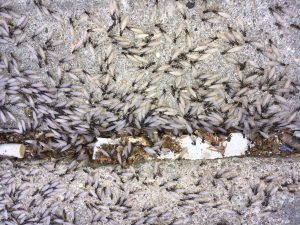Table of Contents
Termites in Furniture:
How Did They Get There? (and How to Treat Them)
Termites are a cringe-inducing nuisance because they spare no piece of furniture once they enter your home. If you think they might be present, call a termite control company as soon as possible.

They are not welcomed in your home and must be exterminated immediately. Aside from destroying your furniture, they reproduce quickly and in large numbers, colonizing in your homes faster than you may have realized.
These problems are just some of the reasons for your rallying call of ‘kill termites on sight,’ which we’ll get to shortly. Let us first discuss the common species of termites that take your furniture hostage:
The Infiltrator Termites in Furniture:
- Drywood Termites – need a low moisture level to survive, breed, and colonize. All they need is soft, old wood to turn it into their nest. These are the termites you’re likely to find in your items of furniture such as chairs, tables, and cupboards.
- Subterranean Termites – likely to be found on your house’s walls if you see some mud tunnels there. The Subterraneans also eat wood and rely on low moisture to strive and thrive.
Now that we know what sort of termites, or baby termites, we’re dealing with let us look over certain symptoms that are sure signs of termites.
The Symptoms of Termites in Furniture:
- One of the common giveaways of termites is mud tunnels. These could be on the walls, roofs or at the bottom edge where the floor meets the wall.
- Damaged furniture is another major warning. If you notice some wood chipped away from your furniture, hammer it slightly to see if the furniture produces any dull, hollow sound.
- Extension of the above, sawdust or tiny feces near or on your furniture is yet another sign of termites.
- Unexplained crevices in your wall, door, window or any furniture may also be a cause of concern regarding termite infestation.
- Although not that common, the shed wings of swarmer on windowsills may also signify termites’ presence in your house.
After you’ve checked for symptoms of termites in furniture, we will now ponder over the question: how did they get into your home’s furniture? This is so you can take the necessary precautions in the future to avoid termites in furniture.
How Did Termites Get into My Furniture?
- At times, furniture isn’t the only thing you get when you purchase it second-handed. Termites may also come along with it.
- If your furniture came into contact with someone else’s furniture, probably during furniture moving or relocating, then termites might have transferred from there as well.
- Any old cardboard boxes stacked somewhere in the house, that could also have attracted some termites.
- If you’re still using your furniture that got soaked in a recent rainfall or snowfall, that could be another reason why termites got in there.
Evaluating the Damaged Furniture
If termites have indeed taken your furniture hostage, you need to assess whether or not it’s worth to save. For instance, if the termites are colonizing in an old chair which you were going to discard anyway, good riddance.
But if the termites are tearing apart your favorite furniture that you have good memories with, then you need to rid it off those annoying creatures.
—————————————

Termite Infestation
—————————————
How to Treat Termites in Furniture
Generally, there are two ways to treat termites if you want to get rid of them on your own:
Chemical Termite Treatment
Termite killers are available online and in shops. You may either purchase one of those or get your hands on some boric acid. After having purchased one:
- Secure the infested furniture in a closed room without any wooden substances inside. This will ensure the termites don’t simply migrate elsewhere.
- Lay your furniture over newspapers, so it’s easier to clean up the mess afterward.
- Before bringing out these chemicals, make sure your hands and face are covered with gloves and a mask since these chemicals are just as poisonous to you as they are to termites.
- Spray the liquid as instructed or inject it into the furniture’s holes and crevices. Immediately after, wrap up the furniture in plastic in order to strengthen the effect of the chemicals.
- It will take a couple of hours for the liquid to dry off completely. After that, you should be able to notice dead termites in the newspapers below.
- To ensure that the furniture is no longer housing any more termites, pour natural oil like Neem oil or essential oil inside the crevices and holes of the furniture.
- Once you’ve done this, cautiously apply some wood sealant on your furniture to seal off all the termite holes, and restore your furniture’s appearance.
Non-Chemical Termite Treatment
Termites can sustain in neither hot temperatures nor cold temperatures:
- Secure your infested furniture in a closed room free of any other wooden substances.
- You can either heat the room up to 150 degrees or cool it down to below 15 degrees.
- Whichever you choose, do it regularly for four days to completely get your furniture free from the termites housed within.
The above should help you killing off termites if they’re in a ‘manageable’ quantity. If these treatments don’t work or if you face a more serious termite infestation throughout your home, you might want to seek help from a professional pest control company who is licensed for this specific work.

Related Articles:
- The Truth About Termites
- Termites in Furniture
- Drywood & Subterranean Termite Signs, and Treatment
- Baby Termites vs. Adult Termites
- What Is Termites Role in the Ecosystem?
- Flying Ants vs. Winged Termites
- 6 Interesting Facts About Termites
- Termites in House: How to Avoid the Mighty Home Mites
- Termite Infestation Hot Spots in Your Home
